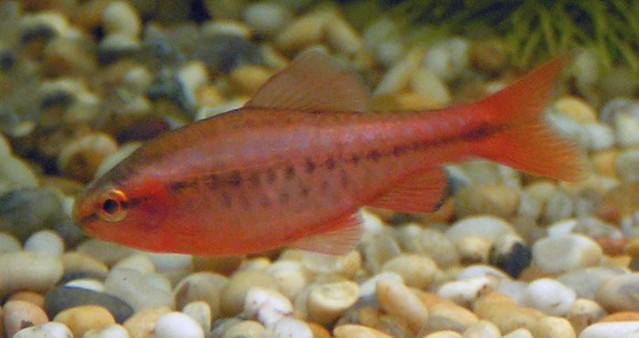 |
| Photo: Wikipedia |
Naming Confusion
This fish has many names. Other Common names are Golden Barb, Schubert's Barb, Green Barb, Half Stripped Barb, China Barb, Chinese Half Stripped Barb and Six Banded Barb. Other Scientific names it has been known by include: Barbus semifasciolatus, Pontius Shubertii, Puntius Shubertii, Barbus Shubertii and Capoeta semifasciolatus.
To add to the naming perplexity, the Gold Barb is often confused with: the Golden Barb (Puntius gelius) or the Gold-finned Barb (Puntius sachsii). The species name Shubertii refers to Tom Shubert of Camden, New Jersey, USA who developed the Gold Barb. He did this by selective breeding, presumably from the wild form of Puntius semifasciolatus, in the 1960's. I remember when I was a teenager keeping fish in the 1960's and later that the Gold Barb was called Barbus Shubertii. It was believed by some people to be a distinct species although there was already a suspicion that it was a form of Puntius semifasciolatus. I do not think that Barbus Shubertiiwas ever a valid scientific name.
Water Conditions
The Gold barb thrives in cooler water than most tropical fish. 18 - 24 degrees C (64 - 75 degrees F) is this fish's preferred range although it will certainly survive several degrees above this and a few degrees below. This means that it is suitable for either a tropical aquarium with the temperature set at 24 degrees C (75 degrees F) or an unheated tank in areas that do not get very cold. It is interesting to note that the color change was not the only change that happened when Mr. Shubert was breeding these fish. The Gold form of the species is a little less cold resistant than the wild type.The wild-type is sometimes sold as the China Barb and is a good aquarium fish although not as attractively colored as the Gold Barb.
The Gold Barb likes fairly soft, slightly acidic water, but does well over a range of pH. I usually aim for neutral (7). It will tolerate a moderate amount of hardness in the water.
Food
The Gold Barb is an easily fed omnivore. Any good quality fish food is an excellent basis for its diet. As with nearly all fish, and most other animals, the Gold Barb benefits from the occasional change in its diet. Live food like mosquito larvae and Daphnia are gobbled up greedily. Frozen bloodworms also make a good treat.
Companions
The Gold Barb is a schooling fish and a minimum of six should be kept. The Gold Barb is not as likely to become a fin nipper as Rosy Barbs and Tiger Barbs but can be kept with these fish as well as with other slightly aggressive fish like Paraguay Tetras, Buenos Aires Tetras and Colombian Tetras. Because the Gold Barb is peaceful it can also be kept with fish like Pristella Tetras and Rummy Nose Tetras. I would not recommend them as companions for Siamese Fighting Fish, Guppies, and Endlers Guppies. Small fish like Neon Tetras and Cardinal Tetras can certainly be kept with smaller Gold Barbs. In all cases, avoid too great a size difference between the fish in your aquarium. Do not put large, aggressive or predatory fish with Gold Barbs.
Breeding
Gold Barbs scatter their eggs over plants, preferably fine leaved ones. The males tend to be brighter in color and when ready to breed will get an orange-red belly. The females are duller in color and plumper. An increase in temperature to about 27 degrees C (80 degrees F) as well as a drop in pH to about 6.5 will tend to encourage them to breed. The spawning can be a little violent, so the tank should be reasonably big. I suggest at least two feet (60cm) long.
The actual spawning will usually take place when the tank starts to get light in the morning. I suggest removing the parents immediately after spawning. The average number of eggs per female is about a hundred although I have known of a female that produced over 400 eggs at one spawning.
An alternative way of breeding them is to have them in as big an aquarium as possible, with large numbers of plants and leave the parents in. Of course, you are likely to get fewer babies surviving, but this is a little closer to what could happen in the wild. A variation on this method is to put them into a well-planted pond in the summer months and catch all the fish before it gets too cold in the autumn (fall). The eggs are a yellowish color. They should hatch in 2-3 days. The fry will eat fine dry foods but benefit from suitable sized live foods at all stages.
Pest Fish
As with all captive fish, do release your Gold Barbs into the wild and do not put them in a situation where they could get out.
Also see: http://www.bettatrading.com.au/Gold-Barb-Fact-Sheet.php Steve Challis has many articles and stories on a diverse range of subjects at http://www.bettatrading.com.au.
Article Source: EzineArticles
|














